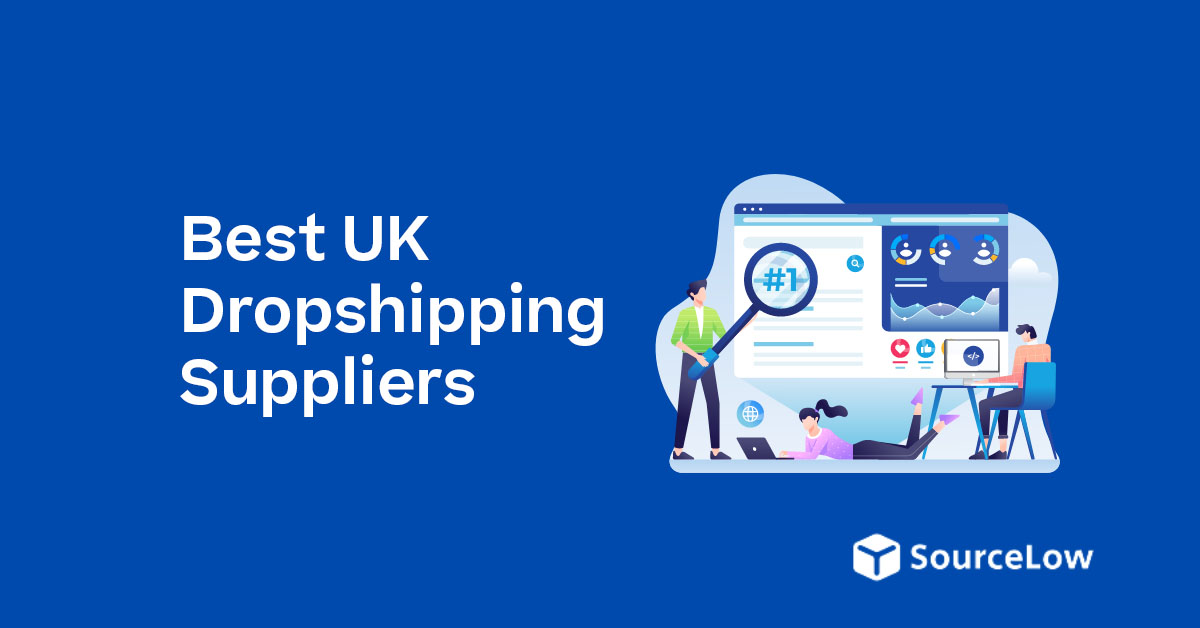Disclosure: We may earn a commission or fee from some of the links in our content. However, this does not affect our recommendations. Learn more.
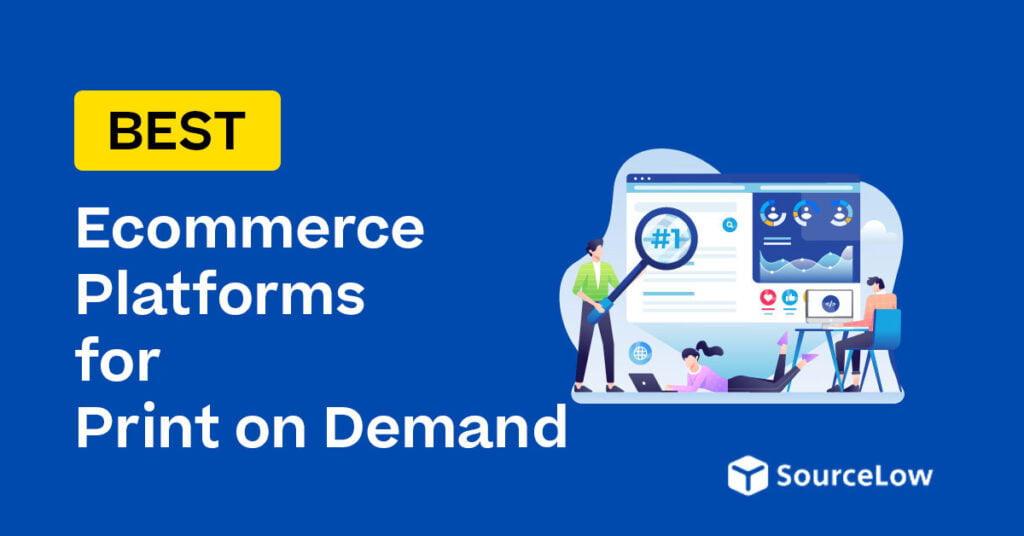
If you’re launching your own POD company in 2024, you’re going to need one of the best ecommerce platforms for print on demand.
While you can always sell POD products through a marketplace like Redbubble, Zazzle, or Spring, having your own online store gives you more room for growth.
With your own ecommerce store, you can build a memorable brand, form deeper connections with your audience through UX design and marketing, and increase your profit margins. The challenge is in figuring out which ecommerce platform to use.
That’s where we come in. Based on our years of experience using and reviewing dropshipping platforms, Print on Demand solutions, and SaaS software, we’ve created this list of the top ecommerce platforms, specially suited to print on demand.
What is Print on Demand?
Print on demand, or “POD” is a business model, similar to dropshipping, which involves working with third-party manufacturers and fulfillment companies to produce custom products and ship them to customers. Your POD supplier does all the work of creating the products, packaging them, and delivering them to customers for you.
This means you just have to focus on building your brand, advertising your wares, and delivering great customer service. There’s no inventory to hold yourself, no need to worry about sourcing the best third-party logistics companies, and almost no limit to what you can sell.
The simplicity of the print on demand business model, combined with benefits like low risks, minimal startup costs, and excellent versatility make it a great choice for new entrepreneurs. In fact, by 2032, experts believe the POD market will be worth a massive $1862.64 billion.
In the last few years, we’ve already helped countless vendors create and build their own print on demand stores, with growth consultancy services, Shopify migration help, and POD supplier reviews.
What to Consider When Choosing an Ecommerce Platform for POD
When it comes to choosing the best ecommerce platform for your print on demand business, there are a few key considerations to keep in mind. Here are just some of the things you should keep in mind when narrowing down your options:
Hosted or Self-Hosted?
Most ecommerce platforms come in two forms: hosted, or self-hosted. Hosted platforms, like Shopify or Wix, are essentially packages of tools you access in exchange for a monthly subscription fee.
The platform creator hosts your site for you, as well as managing performance and security. These platforms are easier for beginners to get started with, but they can lack scalability.
Self-hosted platforms, like WordPress and WooCommerce, require you to purchase your own hosting service and security solutions, and manage store maintenance yourself.
The software may be free to use, but there will be external costs to consider for your hosting provider, domain name, and other factors. For POD stores, we recommend opting for hosted platforms, unless you want an exceptional level of customization freedom.
Crucial Features
The best ecommerce platform for print on demand should either offer the following features as built-in solutions, or provide access to integrated tools:
- Web design tools: Themes, templates, and a comprehensive website editing solution (hopefully with drag and drop functionality) for building your store and user experience.
- Marketing tools: Solutions for attracting customers to your store, such as integrated SEO features, blogs for content marketing, email marketing and social media tools.
- Business management tools: Solutions for inventory and order management, payment processing, customer relationship management, and employee management.
Integrations with Print on Demand Platforms
Probably the most important thing to look for when choosing an ecommerce platform for POD, is the ability for the software to integrate with your POD provider.
Integrations make it easier to upload product information, and mock-ups to your store, automate order processing, and even deliver tracking numbers back to your customers.
Your ideal ecommerce platform should simplify the process of connecting the two platforms, with one-click integrations, apps, or plugins. However, some solutions may offer workaround integration options, with APIs for more advanced automations.
Simplicity and Scalability
Choosing a platform that’s easy to use is crucial when running a print on demand business.
The easier it is to set up your store, create product pages, customize your theme, and manage inventory, the easier it will be to grow your business. Look for a solution that saves you time on complex business processes, and has a minimal learning curve.
Crucially, you should also ensure your store can scale and adapt to your changing business needs. Look for a flexible platform that will continue to deliver excellent results as your business grows, and even enable you to unlock new, more advanced features.
The Best Ecommerce Platforms for Print on Demand
We considered all of the factors mentioned above equally when choosing our list of the best ecommerce platforms for print on demand. Our insights are based on both our own reviews, and our evaluations of customer reviews and testimonials from across the web.
1. Shopify – Best Overall Platform for Print on Demand
Best for: Any company investing in print on demand. Whether you’re a designer, content creator, or entrepreneur, Shopify will give you the tools you need to build a successful business.
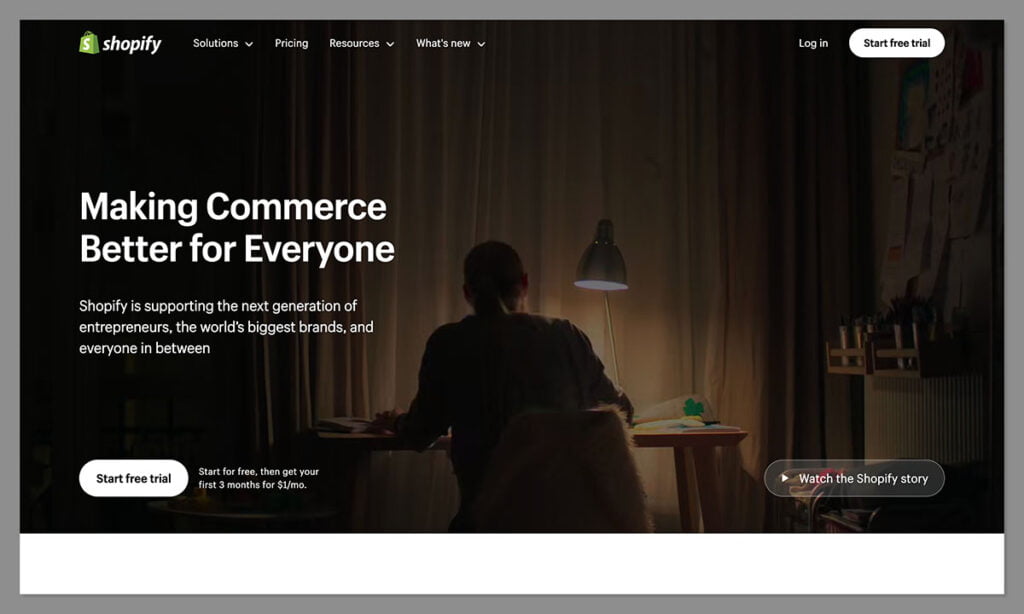
Shopify is one of the world’s most popular ecommerce platforms, and our favorite pick for POD vendors. It supports millions of vendors across 170 countries, with an all-in-one SaaS solution combining marketing tools and SEO, with business management, website design and more.
The platform is easy to use for beginners, and scalable enough to support growing brands. Plus, it offers exceptional solutions for omnichannel selling (across marketplaces and social media), international selling in local markets (with multiple currencies), and automation.
Shopify even makes it easy to grow your profit margins, with Google Ads, Facebook, and Instagram integrations, email marketing, YouTube integrations and more.
Key Features
- Comprehensive inventory and order management tools
- Omnichannel and international sales
- In-depth reporting and analytics, including financial reports
- SEO and marketing tools (email and social media) built-in
- Intuitive themes and convenient website design tools
- Integrations with thousands of business apps
Integrations
One of the reasons Shopify is our top pick for POD vendors, is that it integrates with most of the top POD suppliers and sites.
It works with Printify, Printful, Apliiq, SPOD, Gelato, Zendrop, CustomCat, and countless other solutions. In fact, there are over 400 POD apps on the Shopify marketplace.
Pricing
Shopify offers 5 pricing plans in total. The Starter plan for $5 per month doesn’t include website building tools, and is intended more for social selling.
The Enterprise plan, Shopify Plus, focuses on supporting high-volume sellers. The three main plans include:
- Basic: $39 per month
- Shopify: $105 per month
- Advance: $399 per month
The more expensive the plan, the more admin accounts, and features you get. Plus, you’ll get lower transaction fees and higher shipping discounts.
Pros
- Excellent 24/7 support on all plans
- No turnover or product limits
- Easy to use admin dashboard and website builder
- Excellent range of themes and customization options
- Large number of print on demand apps
- Marketing, SEO, and business management features built-in
Cons
- All plans include transaction fees
- Limited options for checkout customization
2. Wix – Best for Ease of Use
Best for: Smaller print on demand stores or entrepreneurs on a budget looking for affordable prices, easy-to-use tools, and convenient features.
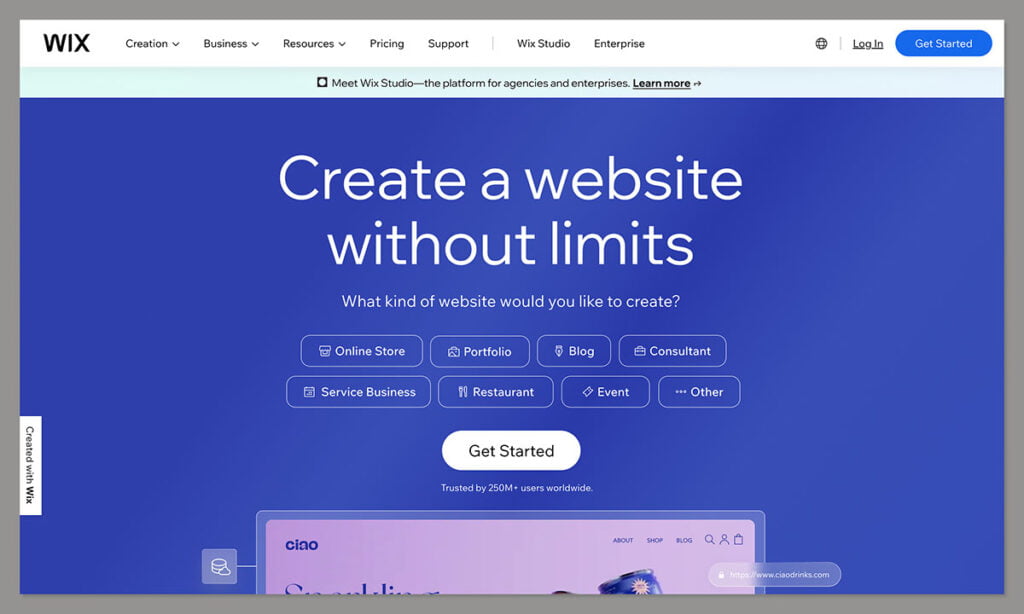
If you want simplicity from your ecommerce platform for print on demand, Wix is a great choice. It’s a convenient, and low-cost website building solution, with built-in AI design tools, a wide range of themes to choose from, and intuitive marketing tools.
Wix also gives companies access to a range of bonus features, like logo design tools, SEO toolsets, and secure web hosting options. Trusted by 250 million customers worldwide, this platform simplifies the process of building a compelling store, and it integrates with a host of POD apps.
Key Features
- Free SEO and logo design tools
- AI powered website design options
- Omnichannel sales options for marketplaces and social media
- Excellent website templates, and a drag-and drop site builder
- App development options
- Facebook, Instagram, and email marketing tools
- Order and inventory management capabilities.
Integrations
While there are fewer POD apps available on the Wix app store than you’ll get from Shopify, you can still integrate with leading solutions like Printy6, Printful, Printify, Gelato, AutoDS, and more.
Pricing
To sell products through Wix, you’ll need one of their business-focused plans, with included payment processing, and support for unlimited products. These include:
- Basic: $27 per month
- Unlimited: $32 per month
- VIP: $59 per month
Notably, Wix doesn’t charge transaction fees on any plan.
Pros
- User-friendly tools, excellent for beginners
- AI and drag-and-drop site building options
- Attractive range of templates and themes
- Automatic inventory syncing and updates
- Decent number of POD integrations
- 24/7 customer support
Cons
- Difficult to switch between templates
- Limited scalability for larger stores
3. WooCommerce – Best for Customization
Best for: WooCommerce is ideal for companies in search of a highly flexible self-hosted platform, that they can customize to suit their specific needs.

If you’ve chosen the “self-hosted” route for your POD store, WooCommerce could be the best option for you. This WordPress plugin converts a standard WordPress website into a fully functional store, with payment processing, order tracking, and innovative marketing tools.
Because it’s built into the WordPress platform, WooCommerce benefits from all of the exceptional SEO and content marketing features of WordPress. It also works seamlessly with hundreds of different WordPress plugins and apps.
Key Features
- Easy to use website builder (via WordPress)
- Built-in checkout management and payment processing
- Mobile app for managing your store on the move
- Flexible integrations with hundreds of tools
- Real-time and historical analytical tools
- Excellent security and privacy features
- Social media and email marketing capabilities
Integrations
There are dozens of POD plugins you can use with WordPress, including options for Printful, Printify, SPOD, Printy6, Hoplix, and more.
Pricing
The WooCommerce plugin is free to use with self-hosted WordPress websites. However, you will still need to pay for WordPress hosting, your domain name, and security tools. Plus, there may be transaction fees to pay based on your preferred payment processor.
Pros
- Extremely easy to use for beginners
- No monthly subscription fees
- Excellent and secure payment processing
- Vast range of customization options
- Great SEO tools (Through WordPress)
Cons
- Requires you to use WordPress as your CMS
- Some technical knowhow is required for certain features
4. BigCommerce – Best for Scaling Companies
Best for: Anyone who wants a comprehensive platform with tons of built-in features supporting business growth and scalability.

Similar to Shopify, BigCommerce is a feature-rich ecommerce platform, ideal for POD vendors. Although the company offers specialist solutions for enterprise-level companies, they also have a range of packages suitable for smaller companies (with no transaction fees on any plan).
The platform can support headless commerce and omnichannel selling, integrates with a range of POD and dropshipping tools, and includes built-in features for email marketing, social media, SEO, and inventory management. As an added bonus, BigCommerce is surprisingly easy to use.
Key Features
- Convenient website builder with a variety of themes
- Omnichannel and international selling
- Open SaaS with API solutions for automation
- Integrated social media, email, and content marketing tools
- Support for multiple payment methods
- Abandoned cart recovery tools
- Inventory and order management
Integrations
As well as offering access to custom integrations and an open API, BigCommerce also works with Printful, Printify, Printy6, Teelaunch, Gelato, and over a dozen other POD apps.
Pricing
BigCommerce charges no transaction fees on any of its plans, but it does have annual turnover limits, with the basic package only allowing you to make up to $50,000. Plans include:
- Basic: $29.95 per month
- Standard: $79.95 per month
- Advanced: $299.95 per month.
The higher the price of your plan, the greater your turnover limit will be. Plus, there’s the option to ask for a custom “enterprise” plan if you make more than $400,000 per year.
Pros
- Excellent scalability for larger businesses
- Large number of built-in features
- Excellent order management system
- Omnichannel selling capabilities
- Good range of print on demand apps
- No transaction fees on any plan
Cons
- Limitations on annual turnover for each plan
- Building custom integrations can be difficult
5. Sellfy – Best for Built-in POD
Best for: Accessing print on demand capabilities built into your ecommerce platform. Sellfy has its own dedicated POD solution.
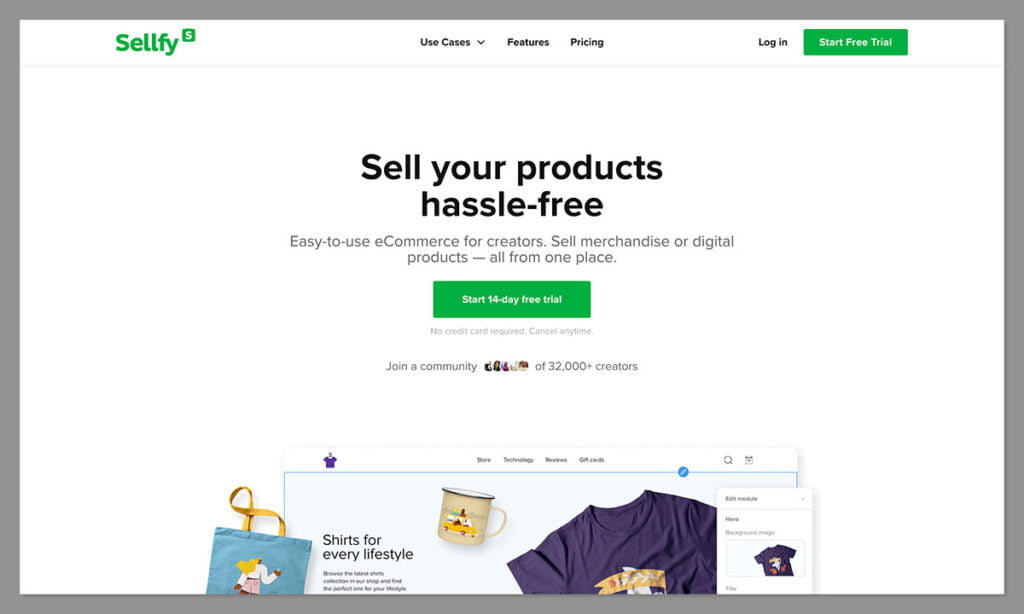
Sellfy is a unique solution for print on demand vendors, combining the core features of an ecommerce platform (website building, marketing tools, and inventory management), with an integrated print on demand solution. If you want to start growing your business quickly, without shopping around for POD suppliers, this could be the best option for you.
Sellfy allows companies to sell virtually any kind of product (physical and digital), supports various payment methods, and even offers access to a mobile-optimized shopping cart.
Plus, you can connect your own domain, run affiliate marketing campaigns, and leverage cart abandonment tools.
Key Features
- Straightforward website builder with customizable themes
- Unlimited products on all plans
- Omnichannel and international selling
- World-class payment processing security
- Affiliate, email, and social media marketing
- Integrated print on demand solution
- Cart abandonment and upselling tools
Integrations
While Sellfy integrates with tools like Google Analytics and Twitter ads, it doesn’t integrate with other POD solutions, because it already has its own print on demand service built-in.
Pricing
Sellfy plans start at $19 per month, or $49 per month if you want to remove Sellfy branding. Each plan has its own limitations on the number of sales you can make each year.
Even the most expensive plan for $99 per month limits your sales to $200k per year. However, there is an option to request a custom plan as your business scales.
Pros
- Print-on-demand solution already built-in
- Cart abandonment and upselling tools
- Excellent payment processing features
- Easy to use for beginners
- Money-back guarantee for peace of mind
- Affordable plans
Cons
- Limitations on turnover on each plan
- Limited integrations for POD
6. Zyro – Best for AI Features
Best for: Companies that want to optimize their growth and selling processes with artificial intelligence, and cutting-edge tools.

Zyro, by Hostinger, is a comprehensive website builder and ecommerce platform that makes it easy to stand out online. It comes with a range of customizable themes to help enhance your store presence, a drag-and-drop editor, ecommerce functionality, and order management. There’s even an integrated CRM for managing customer relationships.
Where Zyro really stands out, however, is with its AI tools that help POD vendors accomplish more with less. There’s an AI image resizer, slogan generator, blog title generator, writing tool, image upscaler, and even an image background remover (great for your POD designs).
Key Features
- Simple drag-and-drop website and page editor
- Universal payment processing solution
- Free hosting and domain for 1 year
- SEO and marketing tools for social media, and email
- Comprehensive range of AI tools
- Business management tools (for shipping, customer, and employee management)
- Reports and analytics
Integrations
Zyro offers a limited number of integrations for business users, however, you can create automations for your business using solutions like Zapier.
Pricing
If you want to sell products on your website, you’ll need an ecommerce enabled plan, starting at $9.90 per month. However, this plan does only allow you to sell up to 100 products. More advanced plans like Ecommerce Plus for $14.99 per month support up to 2,500 products.
Pros
- Excellent AI tools for POD vendors
- Fantastic easy-to-use platform
- Convenient social media and marketing tools
- Universal payment processing options
- Extremely affordable pricing
Cons
- Product limitations on all plans
- Limited range of integrations
The Best Ecommerce Platforms for POD
Ultimately, our number one pick for the best ecommerce platform for print on demand vendors is Shopify.
It benefits from exceptional ease of use, excellent scalability, and integrations with a huge range of POD solutions. However, all of the options mentioned above have something valuable to offer print on demand creators and retailers.
Remember, many of the above platforms also offer free trials or demos, so it’s worth checking out which platforms you can test before you make your choice.
FAQ
Which ecommerce platform is best for Print on Demand?
Shopify is the number one pick for print on demand retailers, thanks to its ease of use, scalability, and wide selection of amazing features. It also works with a huge range of print on demand suppliers and sites, thanks to hundreds of integrations on the Shopify app store.
Is print on demand better on Shopify or Etsy?
While Etsy is a good option for beginners who want to keep their monthly expenses low, Shopify gives you more freedom to build a memorable brand, reach new customers, and scale your business. It also works with a wider variety of print on demand tools.
Can I make a living with print on demand?
Absolutely, but you do need the right strategy. Print on demand is profitable if you choose the right products and suppliers, commit to the right marketing strategy, and build a memorable brand. You’ll also need to commit to delivering exceptional customer service.


